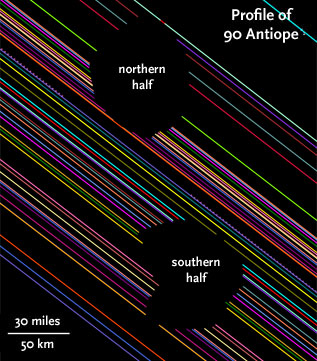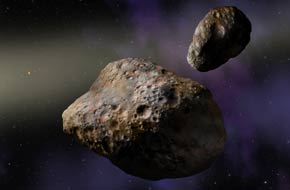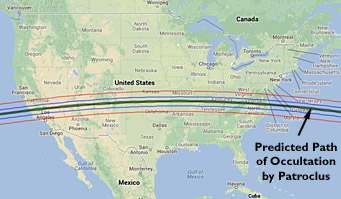Amateur astronomers from California to the Mid-Atlantic states are readying for the binary asteroid 617 Patroclus to occult a star on October 20–21 — late Sunday night or early Monday morning, depending on your location.

More than 50 observations (colored lines) obtained on July 19, 2011, create the chords that silhouette the like-sized halves of asteroid 90 Antiope. The lines are broken where the star LQ Aquarii disappeared on the right side of each body and reappeared on the left. Note the indentation (a crater?) on the lower component. Click on the image for a larger view.
David Dunham / IOTA
If you've ever wondered whether amateur observers can truly contribute to astronomical research, there's no better example than the night of July 19, 2011, when the two halves of binary asteroid 90 Antiope briefly occulted (covered) a star. A network of observers set up nearly five dozen stations to record the event, and their stunning results provided a remarkable "picture" of Antiope's components.
That event was limited to a geographic swath from northern California to sparsely populated Montana, Alberta, and Saskatchewan. But an event late tomorrow provides amateurs from coast to coast across the U.S. to take part in a similarly thrilling event.
This time the target is a binary asteroid named 617 Patroclus. It's a Trojan asteroid, sharing Jupiter's orbit and trailing the giant planet by 60°. Like Antiope, it is a pair of nearly equal components. The larger half takes the name Patroclus, the smaller one Menoetius; their respective diameters are roughly 76 and 70 miles (122 and 112 km).

A depiction of 617 Patroclus and its companion, named Menoetius. The two bodies are 122 and 112 kilometers (76 and 70 miles) wide, respectively, and orbit each other every 4.3 days. They are separated by about 680 km.
However, unlike Antiope, the Patroclus pair is farther apart. Ground-based telescopes, using adaptive optics, show them separated by 425 miles (680 km) in nearly circular orbits that are currently tilted to our line of sight.
A successful occultation campaign tomorrow night could improve astronomers' knowledge of Patroclus considerably. So David Dunham, who heads the International Occultation Timing Association (IOTA), has put out a nationwide call for observations. But before you go dashing off into the night take note of two important things.

The predicted path of the occultation by asteroid Patroclus on October 20-21, 2013, crosses the middle of the continental U.S. The outer lines are about 240 miles (360 km) from the track's center. Click here to get the full interactive map.
Derek Breit
First, location. As seen at right, the predicted path is a wide and uncertain swath that runs across the nation's midsection from California to the Mid-Atlantic states. To find out if your location is "in," "out," or a "definite maybe," check out this interactive map.
Even if you're within this zone, you might not see anything because the exact locations where each Patroclus component will occult the star is uncertain. In fact, these outages could occur well north or south of the indicated track. According to Dunham, "The uncertainty zone that we need to cover to ensure success is at least 450 miles (720 km) wide, extending from southernmost Pennsylvania to central South Carolina on the East Coast, and Sacramento to San Diego in href="http://www.asteroidoccultation.com/observations/NA/21Oct2013_Patroclus_m617cntr.jpg" target="new_window">central states, and East Coast.
Second, timing. This is a late-night event no matter where you are. The asteroids' twin shadows race east to west, starting at 6:42 Universal Time (2:42 a.m. EDT on Monday, October 21st) along the Atlantic coast and ending at 6:46 UT (11:46 p.m. PDT on Sunday, October 20th) in California.
The target star, TYC 0646-00730-1, is in southeastern Aries at right ascension 2h 47m 58.78s, declination +14° 05′ 58.7″ (about 1.3° southwest of the 5th-magnitude star Sigma Arietis). At magnitude 9.6, the target star is reasonably bright — but you'll have some interference from a fat gibbous Moon about 25° away.
You won't see the asteroid itself, which is about 15th magnitude; you just need to see the star. Dunham says that if one component of the asteroid covers the star from your location, you'll see an abrupt (5-magnitude) drop for up to 8 seconds. Also, be sure to look both before and after the predicted time for your location — if the components turn out to be oriented along the direction of motion, you might see two dropouts separated by about 40 seconds. "More likely, only one component will occult the star for a given observer," Dunham explains, "or unfortunately even more likely, no event will occur due to the uncertainties."
You won't need high-end equipment to see or record this event. But even if you're looking by eye, be sure to use a GPS-based time standard or the tried-and-true WWV short-wave broadcasts. To be most valuable, your observations should be recorded on a video camera or an astronomical CCD (details here). Carefully-made visual observations are also valuable, Dunham notes.
Links to path maps, finder charts to locate the star, and much other useful information about this rare and important event can be found here.
And here's some general information about observing occultations.
 1
1









Comments
Frank Reed
October 19, 2013 at 2:09 pm
And don't forget, coming soon... an amazing astronomical spectacle: REGULUS will vanish on March 19/20, 2014 for about 15 seconds. An oocultation of a first magnitude star by an asteroid is a rare event. It's estimated that this happens once a decade somewhere on Earth but usually visible from remote locations. Only a handful of people on Earth have ever witnessed such an event. For this Regulus occultation, the 40-mile-wide path will cross the North Atlantic near Bermuda headed northwest and then right across New York City and from there up towards Syracuse and into Ontario. Potentially hundreds of thousands of people might see a bright star vanish from the sky. Mark your calendars... Original credit goes to ephemeris calculation expert Aldo Vitagliano for publicising this event: http://chemistry.unina.it/~alvitagl/solex/.
You must be logged in to post a comment.
You must be logged in to post a comment.